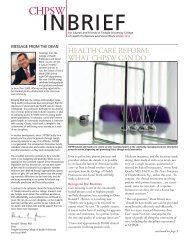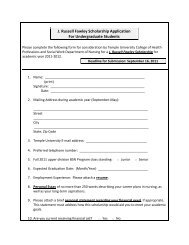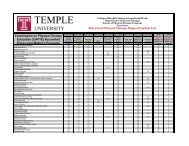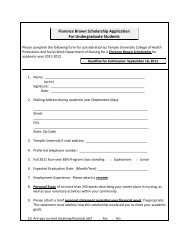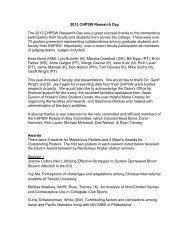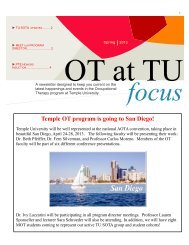Phonetics & Phonology (CSD 2209) - CHPSW - Temple University
Phonetics & Phonology (CSD 2209) - CHPSW - Temple University
Phonetics & Phonology (CSD 2209) - CHPSW - Temple University
You also want an ePaper? Increase the reach of your titles
YUMPU automatically turns print PDFs into web optimized ePapers that Google loves.
Spring 2012 Preliminary Syllabus for <strong>Temple</strong> <strong>University</strong><br />
<strong>Phonetics</strong> & <strong>Phonology</strong> (<strong>CSD</strong> <strong>2209</strong>)<br />
Sections 001, 002<br />
Dr. Brian D. McHugh, Associate Professor<br />
Times: TTh 8-9:40 (section 001), 1:30-3:10 (section 002)<br />
Classrooms: RH 211 (section 001), WH 351 (section 002)<br />
Office hours: 3:30-4:30 and by appointment:<br />
• To set up an appointment, best to email me or talk to me after class,<br />
or use the signup sheet often posted on my office door.<br />
• Check <strong>Temple</strong>'s online courseware system, Blackboard (Bbd), for any changes in ofc hrs.<br />
Office: Weiss 115<br />
Telephone: 215-204-8774 (1-8774 on campus)<br />
Email: bmchugh@temple.edu<br />
Required Texts: Small, Larry H. (2012) Fundamentals of <strong>Phonetics</strong>: A Practical Guide for Students, 3 rd ed.,<br />
Pearson/Allyn & Bacon, 2005. (abbreviated S) ISBN 9780132582100 (book only) or<br />
9780132700641 (book & CD).<br />
Davenport, Mike & S.J. Hannahs (2005) Introducing <strong>Phonetics</strong> & <strong>Phonology</strong>, 3 rd ed.,<br />
Hodder Arnold. ISBN 9781444109887. (abbreviated D&H)<br />
Add’l Readings: Readings from other sources are posted on Bbd, accessible through tuportal.temple.edu.<br />
Prerequisite: Comm Sci 1108 or the equivalent.<br />
Purpose of the course: This course examines phonetics & phonology, the subsystems of language that<br />
govern (1) the physical properties of speech sounds and (2) the cognitive representation and function of speech<br />
sounds in the grammatical system that underlies spoken language. The learning outcomes this course is<br />
designed for are detailed on the KASA document that forms the last page of this syllabus, but broadly they<br />
amount to (1) the acquisition of a body of knowledge relating to phonetic taxonomy, (2) the mastery of<br />
techniques of data description & analysis in phonetics (the study of speech production & perception), (3)<br />
analytical reasoning skills, and (4) techniques of data description & analysis in phonology. Your success in<br />
achieving these outcomes is evaluated on the basis of your performance on a series of exams that measure (1)<br />
memorization of a body of taxonomic knowledge, (2) analytical skills & application of knowledge to the<br />
tasks of phonetic transcription and phonological problem solving.<br />
In other words, mastery of the knowledge & skills taught in this course will enable you to<br />
(a) describe & understand the mechanics of the speech sounds of English & many other languages<br />
(b) transcribe words, phrases or sentences of English broadly & narrowly,<br />
(c) do phonemic analysis of data sets from one or more languages,<br />
(d) know the major distinctive features & use them appropriately as a tool for distinguishing sounds &<br />
formulating phonological rules & constraints,<br />
(e) interpret & generate phonological rule notation & identify phonological process types rules belong to,<br />
(f) know the components of the syllable, draw syllable structure trees & syllabify words, and<br />
(g) have some understanding of how to work with rule ordering (or constraint ranking), derivations, and rule<br />
evidence from alternations rather than phonemic analysis.<br />
KASA: On Bbd, in the same folder as the syllabus, you will find a form that satisfies the latest bureaucratic<br />
demands of the American Speech-Language-Hearing Association (ASHA). If you are taking this course as a<br />
prerequisite for graduate study in speech-language pathology or audiology, you must retain & fill out this form,<br />
which will become part of a portfolio you will eventually need for certification in the field. If you are not going<br />
into this field and are absolutely certain that you will never want ASHA certification, you may ignore the form.
<strong>CSD</strong> <strong>2209</strong>: <strong>Phonetics</strong> & <strong>Phonology</strong> McHugh, Spring 2012<br />
Requirements & grading: You will be assigned a series of approximately 12-14 ungraded homework<br />
assignments designed to give you practice with the material, of which you may miss two without penalty. Bring<br />
a highlighter every day to make in-class corrections as we go over the homework.<br />
Examinations: There will be two in-class midterm exams: the first exam will cover phonetic taxonomy<br />
(terminology & concepts), while the second exam will cover featural and phonemic analysis. In addition, there<br />
will be a Final Exam with both in-class and take-home portions, which will focus primarily on phonetic<br />
transcription and more advanced phonological analysis. I may add a few short quizzes to be graded in class. If,<br />
for some extraordinary reason, you cannot take a test on the designated date, you must notify me in advance<br />
of the test and provide adequate documentation of your reason in order to arrange an alternative time. Makeup<br />
exams will be nearly all-essay and given during Finals Week.<br />
Final research project: Throughout the semester you will work in groups on the phonetics and phonology<br />
of an assigned language, presenting your findings to the class at the end of the semester.<br />
Participation: Regular attendance is absolutely essential to your passing the course, as I will often present<br />
material, explanations or activities in class that are not duplicated in the readings. Conversely, there may be<br />
material in the readings that is not fully covered in class, but which you are expected to learn by doing<br />
homework assignments and asking questions in class, by email, or during office hours & appointments. I will<br />
therefore be keeping track of your attendance and making note of how active a role you are taking in your<br />
learning process by means of either in-class, homework, email or office-hour participation. You may miss up to<br />
three classes without penalty.<br />
Course grades will likely be based on the following relative weighting:<br />
Participation/Homework/Attendance 20% Final Project 10%<br />
Non-final Exams (and any quizzes) 40% Final Exam 30%<br />
Statement for Students with Disabilities:<br />
Every effort will be made to accommodate students with disabilities. Documentation from the Office of<br />
Disability Resources and Services (DRS) must be presented well in advance of the first exam. For more<br />
information or to contact DRS, call 215-204-8531 (1-8531) or visit their website: www.temple.edu/disability/<br />
Examination Policy for Non-native Speakers of English:<br />
It is the policy of the Communication Sciences Department to allow students whose native language is not<br />
English extra time for the completion of in-class exams. I will also be happy to explain to you any unfamiliar<br />
vocabulary or phrasings in my exam questions.<br />
Policy on Academic Honesty:<br />
See the <strong>Temple</strong> <strong>University</strong> Code of Conduct, widely available from your student materials, student bulletin, the<br />
Dean of Students Office, Student Assistance Office, or online at<br />
http://www.temple.edu/bulletin/Responsibilities_rights/responsibilities/responsibilities.shtm.<br />
Policy on Academic Freedom:<br />
Freedom to teach and freedom to learn are inseparable facets of academic freedom. The <strong>University</strong> has a policy<br />
on Student and Faculty and Academic Rights and Responsibilities (Policy #03.70.02) which can be accessed<br />
through the following link: http://policies.temple.edu/getdoc.asp?policy_no=03.70.02.<br />
Academic Standards: It is your responsibility to remain in good academic standing within the <strong>University</strong> and<br />
your college. Undergraduates matriculated in the College of Health Professions & Social Work (<strong>CHPSW</strong>) must<br />
earn a C or better to count a course toward their major. (C- is not considered passing in <strong>CHPSW</strong>.) This course<br />
is required for both of the majors – Linguistics and Speech-Language-Hearing – offered by the Department of<br />
Communication Sciences & Disorders (<strong>CSD</strong>).
<strong>CSD</strong> <strong>2209</strong>: <strong>Phonetics</strong> & <strong>Phonology</strong> McHugh, Spring 2012<br />
Tentative Course Outline<br />
Week Dates Topics Readings Hwk<br />
1 1/17 Course overview, diagnostics, “horse sentence,” preliminaries S1-2, Daniels, D&H1,<br />
1/19 Overview of linguistics, dialects, prescriptivism, vocal tract etc. (folder 0)<br />
2 1/24 Speech vs. writing (orthography), writing systems, fonts LF15.1 etc. (folder 1) #1<br />
1/26 <strong>Phonetics</strong> overview, sonority hierarchy, syllables, S3, hdts, etc. (f. 2)<br />
minimal pairs as evidence of phonemic contrast<br />
3 M 1/30 Last day to drop a course<br />
1/31 English consonant taxonomy S5, V&C10 (f. 3) #2<br />
2/2 English vowel taxonomy, acoustic phonetics S4, V&C11, D&H5 (f. 4)<br />
4 2/7 English suprasegmentals, connected speech S6 (f. 5) #3<br />
2/9 Narrow transcription<br />
5 2/14 Review, transcription practice Review sheets (f. 6) #4<br />
2/16 FIRST EXAM<br />
6 2/21 Distinctive features as "digitized" phonetic parameters used to D&H 7; Schane #5<br />
capture natural classes, contrasts, rule changes; binary values, 33-41, 111-116,<br />
economy principle (Occam's Razor), markedness, redundancy Feature Guide (f. 7)<br />
2/23 Feature practice, sounds of the world’s languages V&C12-14, World<br />
<strong>Phonetics</strong> Charts (f. 8)<br />
7 2/28- Phonemic analysis: complementary distribution as evidence; D&H 8, Schane pp. 49-52, #6<br />
3/1 basic phonological processes: assimilation, dissimilation; Katamba 5, Flowchart (f. 9)<br />
obligatory vs. optional rules, allophonic free variation<br />
SPRING BREAK: NO CLASS 3/6-3/8<br />
8 3/13- No class: groups meet to work on final projects #7<br />
3/15<br />
9 Tu 3/20 Last day to withdraw from courses<br />
3/20 Phonemic analysis & rule writing, cont’d (f. 7, 9) #8<br />
3/22 Review (f. 10)<br />
10 3/27 SECOND EXAM<br />
3/29 Basic morphological analysis Handouts (f. 11)<br />
11 4/3 Alternations & neutralization: beyond the phoneme; D&H 9, Schane 53-61, #9<br />
more phonological rule types & processes Katamba 6 (f. 12)<br />
4/5 Syllable structure, phonotactic constraints, stress patterns D&H 10 (f. 13)<br />
12 4/10 Prosodic domains, fast speech rules, tone & intonation D&H 10, cont’d #10<br />
4/12 Rule interaction: derivations, rule ordering, levels D&H 11 (f. 14) #11<br />
13 4/17 Rule interaction; transcription & analysis of children’s S7 (f. 8) #12<br />
& disordered speech<br />
4/19 Rule interaction; transcription & analysis of dialects S8 (f. 8) #13<br />
& foreign accents<br />
14 4/24- Final Presentations<br />
4/26 #14<br />
FINALS WEEK:<br />
Th 5/3 FINAL EXAM: same room, but earlier (& longer) time: 1-3 (Section 002)<br />
T 5/8 FINAL EXAM: same room, longer time: 8-10 (Section 001)



